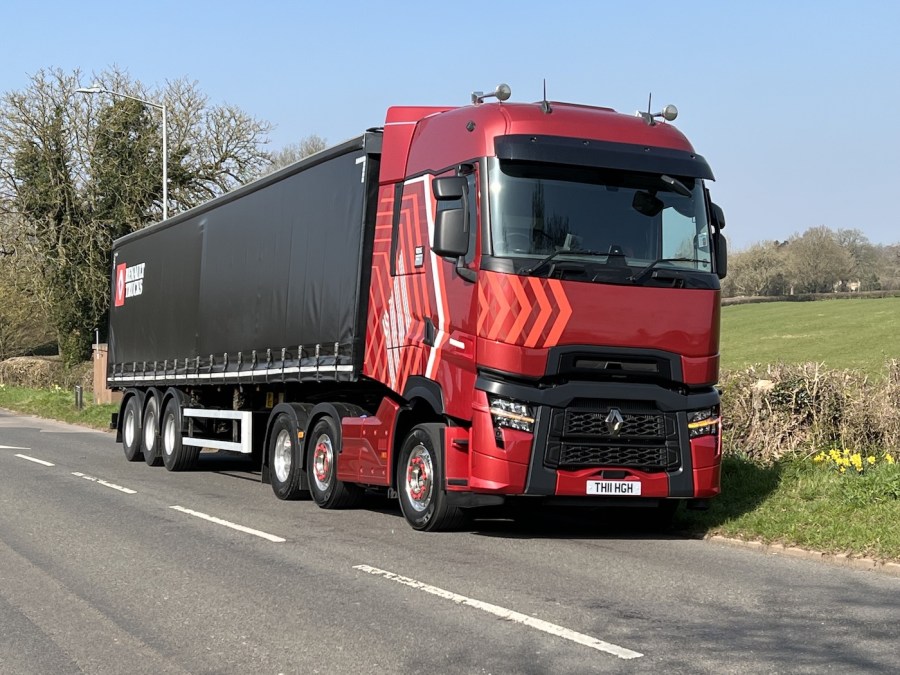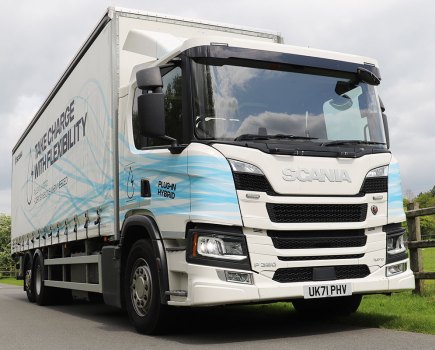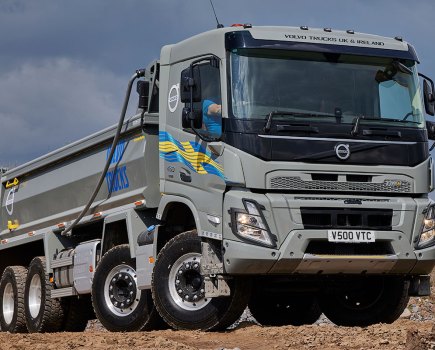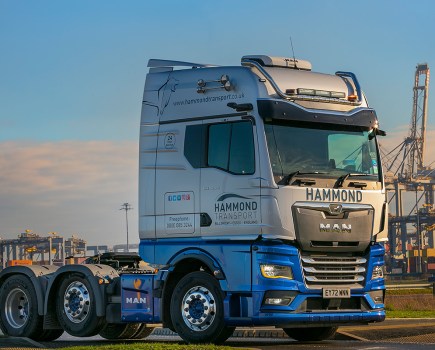Renault facelifted its Range T models in 2021 – their first tweaks since introduction in 2013. Trucking took a flagship Range T High 520 out for a spin and found there really is a serious case for taking one of these trucks…
The delays in orders for new trucks has affected all commercial vehicle manufacturers; but some, like Renault and Iveco, have benefitted from the shortage of stock from other brands. It has put them in the shop window; and while some operators may have been forced into looking at alternative brands because their preferred choice cannot deliver new trucks for a year or so, some are also finding they like the alternatives more than they were perhaps anticipating.
The truck under our microscope for this Driven is a Renault Range T High 520. In incredibly simplistic terms, it has that popular, reliable and dependable (Volvo) driveline, but just with a different cab.
Renault’s cab has some serious flagship appeal. Some might argue it could do with more power – but unless there’s a massive change of heart in Gothenburg, we can’t see Volvo’s 16-litre ever being offered under the big Frenchman’s cab. There isn’t much chance of Renault offering anything above this output without a tweak to the 12.8-litre straight-six, and certainly not in the 580-620 bhp bracket anytime soon.
But this really isn’t an issue, because you don’t need 520 bhp for the majority of jobs this kind of truck will do. It is also available at 440 or 480 bhp, with the latter actually a damn good spec – and we speak from experience.
What the Range T High offers is a flat floor and cavernous interior space, which is gaining in popularity these days. Indeed, it’s only one of three such trucks available on the market – Scania’s S-series and Mercedes’ GigaSpace being the alternatives.
The truck we are testing is a standard 6×2 tractor unit with a midlift, non-steered pusher axle ahead of the drive axle. It has the 12.8-litre straight-six DTI 13 engine delivering 512 bhp from 1430-1800 rpm. The torque rating is 2550 Nm from 1000-1430 rpm. You can have this truck as a 6×2 rear-lift tag-axle or a small midlift – plus, of course, as a 4×2.
Technical overview
This Range T High has common-rail, high-pressure fuel injection, overhead camshaft, and meets Euro 6 emissions using Selective Catalytic Recycling (SCR). It is fitted with a single-plate 430 mm diameter clutch and the Optidriver AT 2612F gearbox with 12 forward ratios and three reverse gears. The ratio range is 14.94-1. An Optibrake+ retarder is fitted, offering a combination of the exhaust brake and valve compression braking coupled to the service brake.
Fitted to the truck’s 3900 mm wheelbase, the front axle is rated at 8000 kg, midlift rated at 7500 kg and the drive axle at 11,500 kg. The rear axle ratio is 2.47:1. Alcoa Dura-Bright aluminium wheels are fitted, shod with 385/55 tyres on the front two axles and 315/70s on the rear.
The cab is the high sleeper. This was launched at the same time as the Range T back in 2013, but initially was only available in left-hand drive form, which meant sales in the UK were few. Then, following a more defined split from Volvo in terms of products, it was offered as a right-hand drive about three years ago – and it’s fair to say it’s proved quite popular.
Last year the Range T (High and ‘normal’) had a minor makeover which included noticeably different headlights, though the same basic shell has been retained. The interior was also refreshed and improved.
External aspects
Before we go in the cab, let’s look at the outside. There are two large external lockers supplemented by two smaller, shallower lockers below them. The latter are obviously only accessible from the outside, but very useful for storing some of the mucky stuff like gloves, straps and the like when you don’t need them.
One of the larger outside lockers can be accessed from the inside, and the cab also has two sizeable under-bunk storage bins. There is also room for a pull-out fridge drawer in the middle section under the bunk.
Above the windscreen are four main storage compartments with doors, one of which has a lock. The sun blinds are electrically operated on the windscreen, but manual on the two side windows. An electric roof hatch can be operated from controls both on the sash and by the bunk.
Having a flat floor means the cab sits very high indeed, so drivers will have to climb four steps to reach the inside. As we’ve often said, if you are doing long-distance work and not necessarily getting in and out of the truck all that often, the hassle of four-step entry is an acceptable trade-off for the extra room in the cab.
But if you are in and out of the cab frequently, then it becomes a bit of a pain. This is especially the case at the start of a shift when you are loading your stuff into the cab, or carrying a flask (or worse, a take-away cup with a hot drink). But if you want a flat floor, you’re going to have to climb to get in and out. It’s a trade-off, and certainly not a criticism of the Renault design.
Inside, the cab is a pleasant place to work or live. As many manufacturers are about to find out, the new DAF XG – and especially the XG+ – cab kicks the behind of any competitor for sheer space, but the Renault certainly has bucket-loads of room.
Renault still has mirrors only, but has hinted at digital camera replacements sometime “soon”. When that will be is anyone’s guess.
Anyway, the high cab treats drivers to an excellent view of the road ahead. The mirrors are pretty good, so rearward vision is fine. There are no really bad blind spots of note.
The Renault has a novel breathalyser that you need to blow into before you can start the truck. An over-the-limit reading will incapacitate the vehicle. In our opinion, this is a great feature that all trucks should have fitted!
On the road
Our first impressions inside our Range T High test vehicle was the driver’s seat is a little too hard; but that said, it didn’t actually make the drive uncomfortable. The seats have armrests, which are always a plus point. The dashboard is okay, but not amazing – certainly not as good as those offered by pretty much all the competition. But while it’s not outstanding, it’s not bad. It’s clear enough, though a little dated compared to rivals.
The truck pulled very well, as you’d expect with 512 bhp available and a load just a shade under 44 tonnes. One thing we did notice was how well the truck handled. There was no rocking in the tall cab, but there was a bit of wind noise inside which was very intrusive. It was a lot nosier than other trucks we’ve driven this year.
We recently spoke to a tramper whose new truck was a Range T High 520 and he was incredibly complimentary about it. Indeed, his only criticism was the internal storage could have been a bit better – but he rated the comfort, space, off-road handling (especially important to him as he does timber work in the Scottish forests), the traction, power and gearbox as very good indeed.
We took the truck for a circular trip around the roads of Warwickshire to take in all road types, and it was a very pleasurable drive. The Range T High was nice and easy to manoeuvre and the braking was very good.
Renault may still have something of a perception issue, but we tend to find those drivers we talk to who have had charge of a Range T (be it occasionally or as their regular trucks) tend to like them. And we understand why. There are some irritating niggles – for example, the cup holder is not close enough to the driver – but then there are irritating niggles on every marque.
VERDICT
The list price for this Range T High was £108,000, and with some discounts you could perhaps secure one for five figures. However, given the general shortage of trucks, discounting new trucks is not in any dealer’s interest at the moment.
So let’s assume you pay £108,000 for this 6×2, top-spec, large-cabbed tractor. Well, actually you are getting a heck of a lot of truck for your buck. The only manufacturer who’d come close for that kind of price (for the specification) would be Iveco or possibly MAN.
And remember, you are getting a Volvo driveline, but not at a Volvo price. In fact, the Range T High is more than a match for an FH Globetrotter. It’s maybe not a deal-clincher, but the Range T High is one of the best trucks for painting. That mass of smooth front is perfect for a good livery; or if airbrushing is your thing, it’s a great blank canvas. If image is important to you, then this truck has it by the shed load.
Another feature that will appeal to operators is its kerb weight of 8623 kg. That’s very impressive for such a large, high-spec unit with the biggest cab, and at least half a tonne lighter than some of the similar like-for-like comparisons. You can save even more weight if you spec a small ‘lite’ midlift, which Renault says reduces overall mass by 250-450 kg.
For the driver, assuming they are not a badge snob, the Range T High is an exceptionally good truck. For the operator, the business case is strong – a decent initial purchase price, great earning potential, and the Volvo engine is exceptionally good on fuel if driven well.
With delays in getting new trucks, checking over a Range T High might be a good move to keep your wheels moving. It might also enable you to appreciate what a hidden gem this truck is.
We like
+ Lots of power
+ Handles well
+ Imposing flagship
+ Superb business case
+ Underrated
We don’t like
– A bit too noisy
– Cab layout could be better
SPECIFICATION
Model: Renault Trucks Range T High 520
Design GCW: 44,000 kg
Chassis: 3900 mm wheelbase
Front axle: 8000 kg capacity
Rear axle: 11,500 kg (drive) 7500 (midlift), 2.47:1 ratio. 385/55 (non-drive), 315/70R22.5 (drive) tyres
Gearbox: Optidrver AT2612F automated 12-speed
Engine: DTI 13 12.8-litre straight-six, SCR
Max power: 512 bhp @ 1430-1800 rpm
Max torque: 2550 Nm @ 1000-1430 rpm
Cab: T High flat-floor, high-roof sleeper






